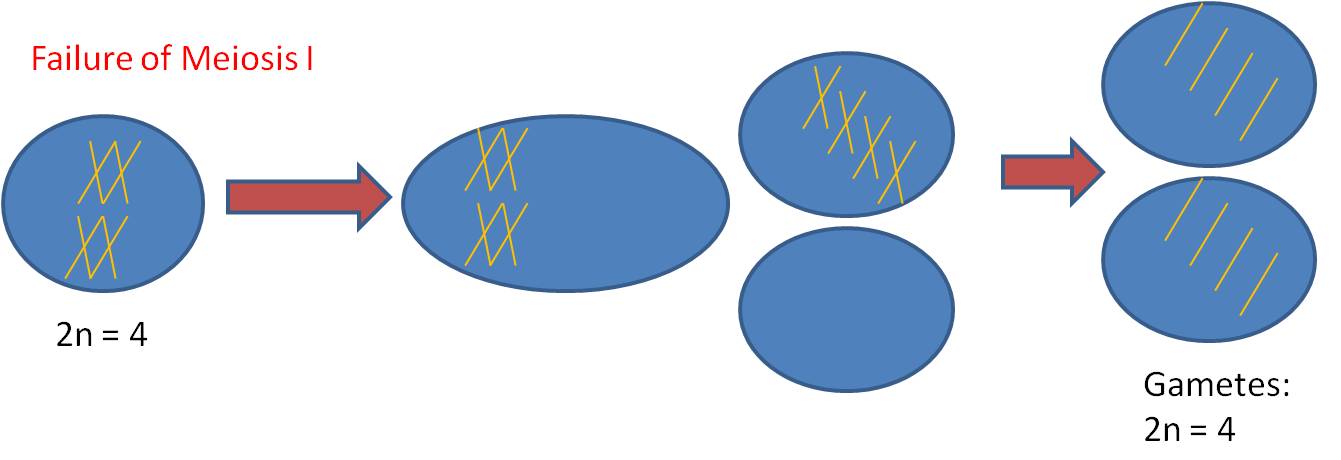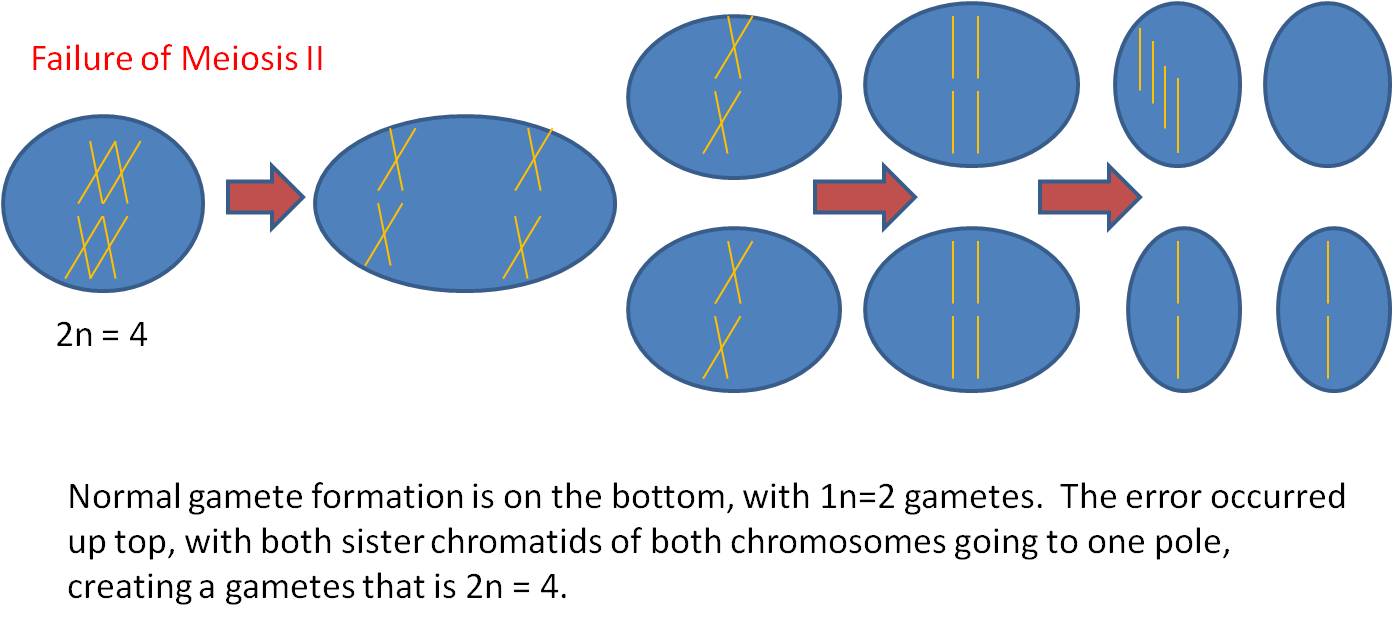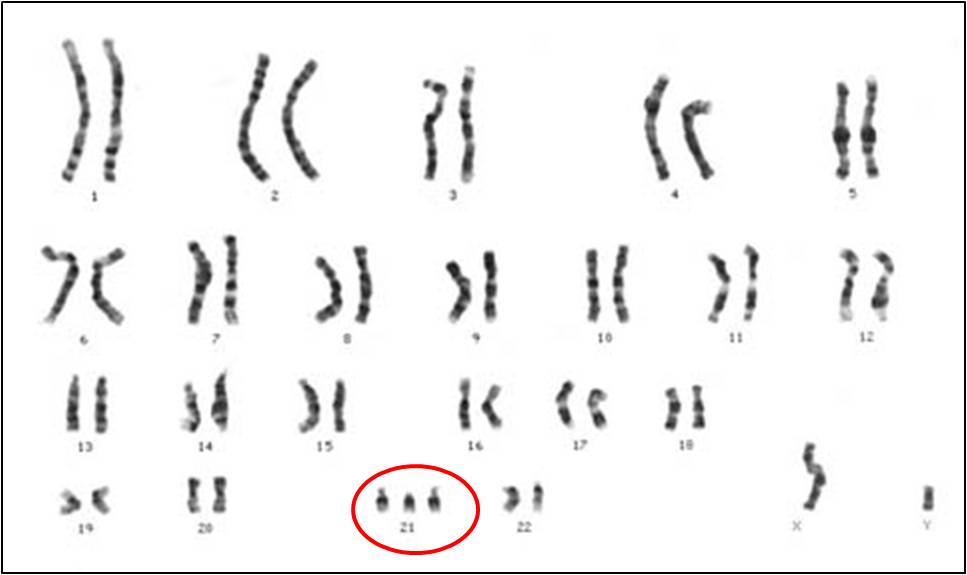

Mutation is defined as a change in the genome. Mutations can occur due to damage to the DNA by mutagens or by errors in DNA replication. If these changes are not repaired before division, they are passed to daughter cells. Mutations occuring in body cells are called 'somatic mutations', and (unless they occur in cells that will become ovaries or testes) they will not be passed to offspring. However, mutations can also occur in reproductive tissues - in the cells that will produce gametes (or spores). These changes will be inherited by offspring. In addition, errors in meiosis can occur because of the incorrect segregation of chromosomes or unequal exchange of DNA during crossing over. These changes will be passed to offspring, also, obviously, as they are happening during the process of gamete formation. These heritable changes are the focus of the this lecture and the next one.
The changes can occur at several levels, changing the number of chromosomal sets, changing the number of chromosomes in a set, changing the number and arrangement of genes on chromosomes, and changing the nitrogenous base sequence of genes. ALL of these changes are mutations, and we will look at each level of changes in order - from large changes in chromosome number to small changes in nitrogenous base sequence.
For the most part, mutations occur randomly. And as you would suspect, making random changes to a complex, functional system like a living cell are probably going to have a negative effect. This is particularly true for large changes, like the gain or loss of individual chromosomes or chromosome sets. In humans and other animals with complex development and tissue specialization, most of the large-scale changes cause such profound problems with development that the embryo does not develop correctly and is spontaneously aborted. Over 90% of all spontaneous abortuses (that are tested) have chromosomal anomalies. By analogy, think about the complex system of an automobile. If you make a large, random change to a functioning car - like taking out the engine, or putting one big wheel on the front right axle - it is unlikely that you will improve the functioning of the system. Small changes are probably going to have a negative effect, also, but it is more likely that a small change has a beneficial effect than a large change. For example, you might randomly change the angle of the rear-view mirror every time you get in the car. Well, sometimes you will throw it off so you can't see, but sometimes, just by chance, you will make a small change that adjusts it to a better viewing angle - even if it was already pretty good.
This is the most dramatic change possible; an addition of an entire SET of chromosomes, changing a haploid gamete to a diploid gamete, or changing a diploid cell into a tetraploid cell.
 1.
Mechanism #1 - Complete failure of Meiosis
1.
Mechanism #1 - Complete failure of Meiosis
a. process

b. result
 2.
Mechanism #2 - Failure of Mitosis
2.
Mechanism #2 - Failure of Mitosis
Here, however, there are 2n male AND 2n female gametes produced. If the plant is self-fertile, these sperm can fertilize these eggs and a 4n zygote will be produced. This is TETRAPLOIDY. - Tetraploid offspring may not survive; there may still be enough of a disruption in the protein concentrations to screw-up development. But, if they can survive, then they WILL be able to make gametes by normal meiosis. Their 4n cells CAN divide evenly, producing 2n gametes.
- This lineage could reproduce itself, and would be reproductively isolated from its originating species because IF their 2n gametes fertilized the haploid gametes of the originating species, a 3n triploid would be produced, which is typically a reproductive dead-end for reasons described, above.
 3.
Frequency of Polyploidy
3.
Frequency of Polyploidy
Polyploidy (>2n) is VERY rare in birds and mammals. The only known polyploid mammal is a small tetraploid mouse that lives in the Andes - it was discovered in 2002. No birds are known to be triploids. However, it is more frequent (but still rare) in fish, amphibians, and reptiles, where there are parthenogenetic 3n sister species of normal 2n species. However, on the whole, polyploidy is rare in dioecious species (where individuals are EITHER male or female). This is probably because the most likely polyploid product in these species is a triploid, which usually has the sterility problems mentioned earlier.
In hermaphroditic species (and particularly self-compatible plants), polyploidy is FAR more common. This is probably because tetraploidy is far more likely, and the tetraploid will be fertile. In fact, about 30-50% of all flowering plant species are polyploid!!!. That means that this mechanism has been a pretty important source of new species. Some genera have species with sequential increases in ploidy. For instance three different species of goldenrods have 14, 28, and 56 chromosomes, respectively. So, a reasonable hypothesis is that the second and third species were formed through polyploid events (failure in mitosis) as described above - doubling their ploidy levels and making new species.
 This
refers to the loss or addition of a single chromosome, not whole sets of chromosomes.
This mutation is called aneuploidy. 'Ploidy' refers
to set, 'eu' means true, and 'an' means not. So,
you have "not a true set".
This
refers to the loss or addition of a single chromosome, not whole sets of chromosomes.
This mutation is called aneuploidy. 'Ploidy' refers
to set, 'eu' means true, and 'an' means not. So,
you have "not a true set".
1. Mechanism:
Non-disjunction - During meiosis, a pair of homologous chromosomes (or sister chromatids) fail to segregate; both go to one daughter cell. So, we end up with a gamete with an extra chromosome, and a gamete that is one chromosome short.
When fertilization occurs with a normal haploid gamete, we end up with a zygote with an extra chromosome - a third chromosome in one homologous 'pair'. (Remember, one gamete inherited BOTH homologs, and then the other parent correctly contributes a single chromosome for this set.) So, this situation is called trisomy (three bodies.) If the other aberrant gamete is involved in a fertilization event, we end up with a zygote with only one chromosome in a given homologous set - this is a monosomy.
2. Human Conditions:
 In humans, these
imbalances are almost always fatal to the developing embryo - they are usually
spontaneously aborted during development (>90% of spontaneous abortions have
chromosomal anomalies). However, some embryos with these conditions can
complete development to birth, and some individuals can survive for decades.
When non-disjunction occurs in the #21 chromosome, TRISOMY 21 occurs. This is
also known as Down's Syndrome. Other autosomal trisomies can survive to birth,
but that is rare and the effects are much more severe. Trisomy 13, Patau Syndrome,
can result in cyclopian eye development (among a host of other deadly anomalies).
Edward's Syndrome, trisomy 18, also causes a rash of typically lethal deformities.
Trisomies in the sex chromosomes are tolerated more often, resulting in XXX,
XXY, and XYY offspring. It is important to appreciate that Down's and sex trisomies
are the trisomies with the LEAST severe effects, where the individual survives
birth and lives for decades. Trisomies should, by chance, be just as likely
for other homologous sets, too; but apparently these trisomies are so devastating
to development that they result in spontaneous abortion.
In humans, these
imbalances are almost always fatal to the developing embryo - they are usually
spontaneously aborted during development (>90% of spontaneous abortions have
chromosomal anomalies). However, some embryos with these conditions can
complete development to birth, and some individuals can survive for decades.
When non-disjunction occurs in the #21 chromosome, TRISOMY 21 occurs. This is
also known as Down's Syndrome. Other autosomal trisomies can survive to birth,
but that is rare and the effects are much more severe. Trisomy 13, Patau Syndrome,
can result in cyclopian eye development (among a host of other deadly anomalies).
Edward's Syndrome, trisomy 18, also causes a rash of typically lethal deformities.
Trisomies in the sex chromosomes are tolerated more often, resulting in XXX,
XXY, and XYY offspring. It is important to appreciate that Down's and sex trisomies
are the trisomies with the LEAST severe effects, where the individual survives
birth and lives for decades. Trisomies should, by chance, be just as likely
for other homologous sets, too; but apparently these trisomies are so devastating
to development that they result in spontaneous abortion.
In humans, the only human monosomy that does, periodically, survive to birth and beyond is the monosomy for the sex chromosome, with 1 X chromosome. This condition, 45, XO, is called Turner's syndrome. No other monosomies are tolerated in humans; all are spontaneously arborted.
3. Karyotypes:
We write a human genotype as follows:
1) total number of chromosomes
2) complement of sex chromosomes
3) any imbalance
So, the karyotype pictured above, for a male with Down's Syndrome, would be
written: 47,XY, +21
Study questions:
- Describe two mechanisms by which polyploids can be produced.
- How can polyploidy create a new species?
- Why are tetraploids more likely to establish a productive population than triploids?
- Draw a cell going through meiosis I, showing how trisomy is produced by non-disjunction.
- Why are trisomies and monosomies usually bad?